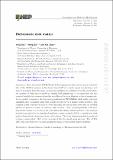| dc.contributor.author | Bai, Yang | |
| dc.contributor.author | Su, Meng | |
| dc.contributor.author | Zhao, Yue | |
| dc.date.accessioned | 2014-04-24T20:18:17Z | |
| dc.date.available | 2014-04-24T20:18:17Z | |
| dc.date.issued | 2013-02 | |
| dc.identifier.issn | 1029-8479 | |
| dc.identifier.issn | 1126-6708 | |
| dc.identifier.uri | http://hdl.handle.net/1721.1/86238 | |
| dc.description.abstract | Both the robust INTEGRAL 511 keV gamma-ray line and the recent tentative hint of the 135 GeV gamma-ray line from Fermi-LAT have similar signal morphologies, and may be produced from the same dark matter annihilation. Motivated by this observation, we construct a dark matter model to explain both signals and to accommodate the two required annihilation cross sections that are different by more than six orders of magnitude. In our model, to generate the low-energy positrons for INTEGRAL, dark matter particles annihilate into a complex scalar that couples to photon via a charge-radius operator. The complex scalar contains an excited state decaying into the ground state plus an off-shell photon to generate a pair of positron and electron. Two charged particles with non-degenerate masses are necessary for generating this charge-radius operator. One charged particle is predicted to be long-lived and have a mass around 3.8 TeV to explain the dark matter thermal relic abundance from its late decay. The other charged particle is predicted to have a mass below 1 TeV given the ratio of the two signal cross sections. The 14 TeV LHC will concretely test the main parameter space of this lighter charged particle. | en_US |
| dc.description.sponsorship | University of Wisconsin--Madison (Start-up funds) | en_US |
| dc.description.sponsorship | SLAC National Accelerator Laboratory (US DOE contract DE-AC02-76SF00515) | en_US |
| dc.description.sponsorship | Aspen Center for Physics (NSF Grant No. 1066293) | en_US |
| dc.description.sponsorship | United States. National Aeronautics and Space Administration (Einstein Postdoctoral Fellowship grant number PF2-130102) | en_US |
| dc.description.sponsorship | Smithsonian Astrophysical Observatory (Chandra X-ray Center, NASA under contract NAS8-03060) | en_US |
| dc.language.iso | en_US | |
| dc.publisher | Springer-Verlag/International School for Advanced Studies (SISSA) | en_US |
| dc.relation.isversionof | http://dx.doi.org/10.1007/jhep02(2013)097 | en_US |
| dc.rights | Creative Commons Attribution | en_US |
| dc.rights.uri | http://creativecommons.org/licenses/by/3.0/ | en_US |
| dc.source | Springer | en_US |
| dc.title | Dichromatic dark matter | en_US |
| dc.type | Article | en_US |
| dc.identifier.citation | Bai, Yang, Meng Su, and Yue Zhao. “Dichromatic Dark Matter.” J. High Energ. Phys. 2013, no. 2 (February 2013). | en_US |
| dc.contributor.department | Massachusetts Institute of Technology. Department of Physics | en_US |
| dc.contributor.department | MIT Kavli Institute for Astrophysics and Space Research | en_US |
| dc.contributor.mitauthor | Su, Meng | en_US |
| dc.relation.journal | Journal of High Energy Physics | en_US |
| dc.eprint.version | Final published version | en_US |
| dc.type.uri | http://purl.org/eprint/type/JournalArticle | en_US |
| eprint.status | http://purl.org/eprint/status/PeerReviewed | en_US |
| dspace.orderedauthors | Bai, Yang; Su, Meng; Zhao, Yue | en_US |
| mit.license | PUBLISHER_CC | en_US |
| mit.metadata.status | Complete | |
